
AAVSOnet began in 2005, as the result of a collaboration between observers united by the pursuit of variable star science. Since then, it has prospered, growing to encompass 10+ observatories around the globe, and delivering over 2.9 million images to AAVSO members.
For a normal user of AAVSOnet, the distinction between the Faint Star Monitors and Bright Star Monitors is not important—when you submit a proposal, we will choose the best telescope for your proposal based on its specifications, not its name. However, the Faint Star Monitors and Bright Star Monitors have different histories, so we'll discuss them separately in the text below.
The Faint Star Monitor observatories
The Faint Star Monitor (FSM) observatories are a subset of AAVSOnet, although they are not owned by the AAVSO; instead, we've made agreements which allow AAVSO members access to these large telescopes. Most are concentrated in the American Southwest, with the notable exception of FSM-OC61 in New Zealand. Each observatory features a half-meter class telescope, ideal for observing faint targets (10 < Vmag < 20). As part of AAVSOnet, FSM stations are available for use by AAVSO members; click here for details.
SRO and the birth of AAVSOnet
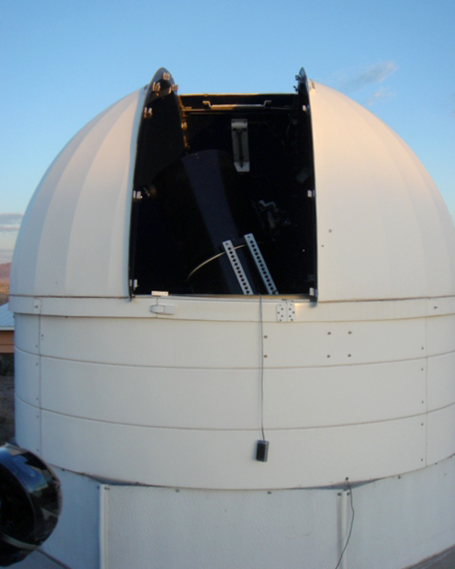
Sonoita Research Observatory
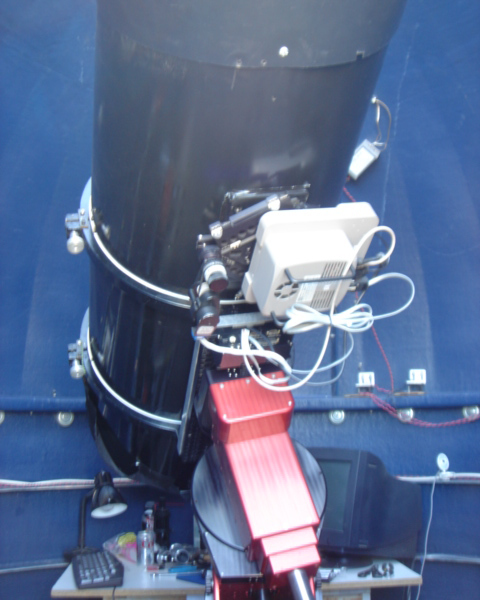
SRO's new 50cm f/4
AAVSOnet had its humble beginnings at a Society of Astronomical Sciences meeting in 2005, when Arne Henden, then the Director of the AAVSO, was approached by Dirk Terrell, Walt Cooney, and John Gross, wanting to talk about an observatory. Dirk, Walt, and John had been running the Sonoita Research Observatory in Arizona remotely, and they saw an opportunity to improve its operation and begin obtaining professional-level photometry with its C-14 telescope.
As a result of their collaboration, a calibration pipeline was created at AAVSO HQ which not only performed basic calibration of images, but also extracted photometry and performed transformed differential photometry. This system laid the groundwork for the modern software which powers AAVSOnet and its Epoch Photometry Database today.
At first, SRO was only used to calibrate variable star fields for AAVSO observers, but we soon found that we had more clear nights than the calibration survey called for. With time to spare, in 2008, SRO opened up for use by the general membership of the AAVSO, kickstarting the remote access program which would later become known as AAVSOnet.
In 2010, SRO underwent a major upgrade, replacing its original C-14 assembly with a powerful 50cm f/4 three-mirror system, armed with an SBIG STL-6303E CCD. This combination has served the observatory well, and as of 2022, SRO is still going strong, sending images to AAVSO members around the world.
Building a network
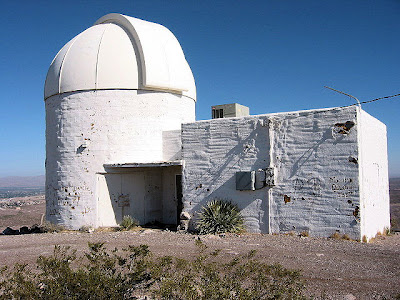
Tortugas Mountain Observatory
Since SRO first came online, we've made several other agreements with half-meter class telescopes, frequently funding refurbishment and providing our expertise in robotic enhancements in exchange for the ability to add each observatory to AAVSOnet for membership use.
Our second such agreement came in 2006, when we signed an MoU with the University of Canterbury, granting AAVSO members remote access to dark southern skies through the university's Optical Craftsman 61cm telescope on Mt. John in New Zealand.
Following suit a few years later came the Tortugas Mountain Observatory, just outside Las Cruces, New Mexico. Home to a unique 24" f/5 Boller and Chivens Newtonian, we were fortunate to be able to incorporate it into the network in 2010, after an agreement with New Mexico State University.
As of 2022, Madrona Peak Observatory had just become the latest addition to the FSM lineup, joining AAVSOnet as MPO61.
The Bright Star Monitor stations
The Bright Star Monitor (BSM) stations are a subset of AAVSOnet. There are currently six BSM stations, distributed from Australia to New Hampshire. Each station features a small and fast robotic telescope, optimized for rapid observing of bright stars (2.0 < Vmag < 13.6). As part of AAVSOnet, BSM stations are available for use by AAVSO members; click here for details.

Why BSM?
In 2008, the AAVSO found itself preparing for a major celestial event: the historic 2009-2011 eclipse of epsilon Aurigae. The last eclipse had been in the early 80’s, and since then, astronomical technology had advanced in leaps and bounds. As amateurs around the globe turned their cameras, telescopes, and eyes to the sky in anticipation, the science promised to be stunning. There was just one problem: none of the telescopes that the AAVSO had access to were capable of obtaining photometry of such a bright star.
We soon realized that this was not an isolated case. There are hundreds of variable stars brighter than 4th magnitude, and thousands brighter than 7th magnitude. Although their brightness offers up a wealth of information, these fascinating targets tend to be systematically overlooked by professionals and amateurs alike. Professional all-sky surveys such as ASAS-SN and LSST are optimized for monitoring faint stars, and bright stars saturate their detectors, producing no useful data; most amateurs have similar struggles with their own equipment. Visual observers have been doing an excellent job of following the bright long-period variables such as Mira and R Sct, but there are still a great many bright variable stars in the sky which have low amplitudes, and have historically not received the high precision photometry they require.
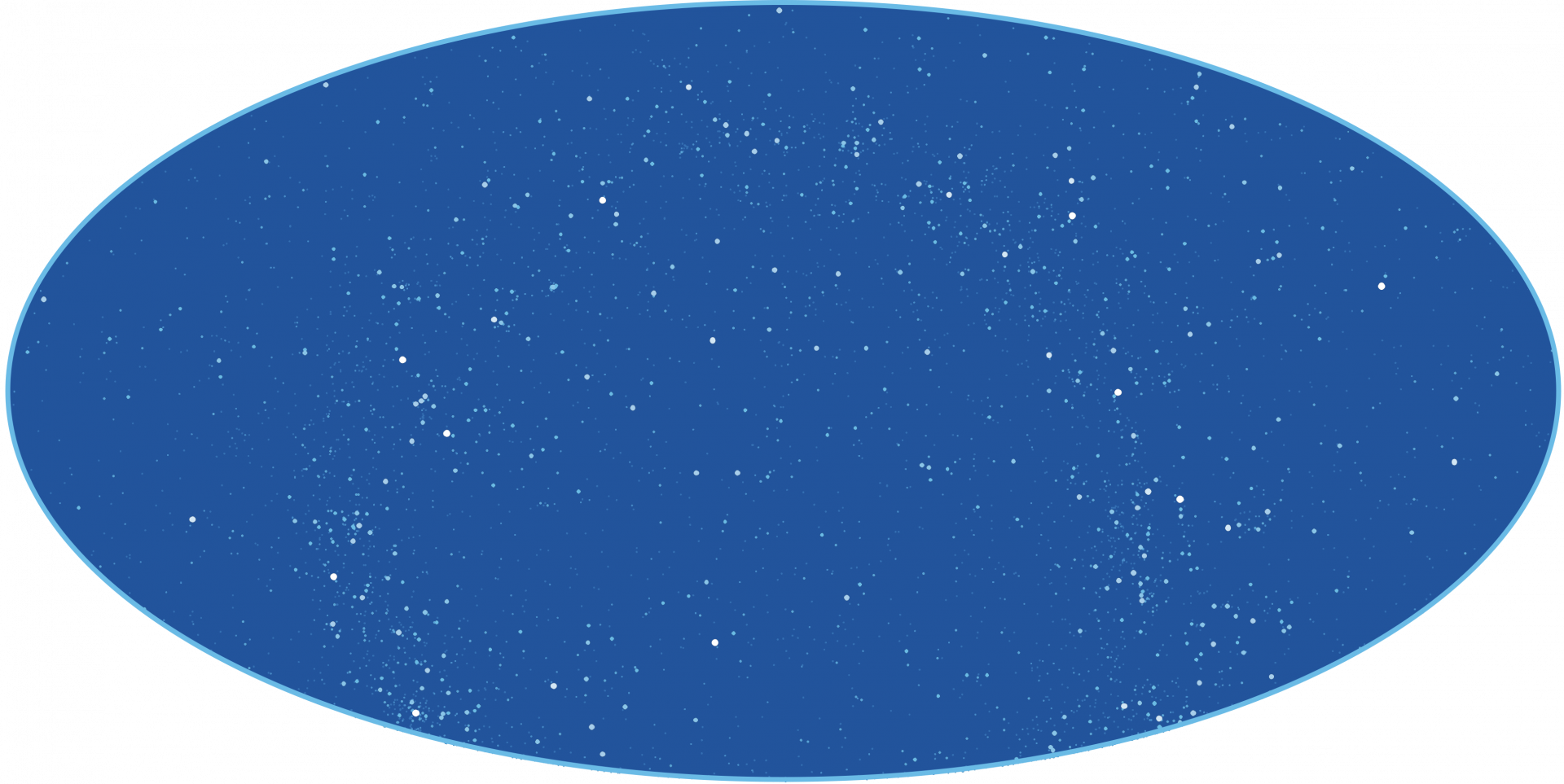
Above: A map of every variable star visible to the naked eye
(those which peak brighter than magnitude 7.5)
Designing the first station
We looked at what type of equipment would be best for recording quality photometry of bright stars, and came up with a list of requirements:
- The telescope should have a small aperture—that way, the star will not saturate at reasonable exposure times.
- The telescope should produce sharp images, so that field stars won’t cause contamination.
- The system should have a wide field of view, since bright variable stars rarely have bright comparison stars nearby.
- The camera should be equipped with multiple photometric filters, so that the data can be transformed.
- The mount should be high quality, so that we can move rapidly all over the sky, accurately dialing in many fields over the course of a single night.
- Since the targets are bright, light pollution isn’t a problem, but the location should be a place which gets lots of clear weather.
- All of the equipment should be compatible with complete robotic operation, since the telescope will need to examine dozens of targets every night.
- Finally, we want to achieve all of the above using only existing commercial equipment and software - that way the system can be replicated easily.
With these requirements in mind, we began to investigate simple, inexpensive systems.
To DSLR, or not to DSLR?
One interesting option was that of using a standalone DSLR, mounted on a decent telescope mount. In the end, we ultimately decided against DSLRs, due to their lower dynamic range, lack of standard filters, restricted wavelength range, and poorer capacity for remote control when compared to conventional CCD/CMOS cameras. However, DSLR-based systems are still powerful tools capable of 0.02mag photometry, and should not be overlooked for use by others.
What about a telephoto lens?
We also considered hooking up a CCD camera to a commercial telephoto lens, which would solve many of the above issues without requiring a full-size telescope and mount. CCD–telephoto systems have been used by many professional surveys in the past, including ASAS-SN, ASAS, and StarDial (which ran with a 50mm lens on an ST-7 for nearly a decade!). Unfortunately, high-quality telephoto lenses are not cheap, and are hard to focus remotely, making them a poor choice for our project.
The original BSM
In the end, we settled on a scientific CCD camera, a filter wheel with filters, a GOTO mount, and commercial software, housed at Astrokiolhoz Observatory under the dark skies of Cloudcroft, NM. The main system parameters are listed below.
The original BSM |
||||
|---|---|---|---|---|
Telescope |
60mm f/6.2 | Takahashi FS-60CB (with field flattener) | Field of view: 127’x84’ |
|
Camera |
Model: SBIG ST-8XME |
Pixel size: 9x9μm |
Image scale: 4.968”/px |
Saturation: nonlinearity begins at 52000 ADU |
| Read noise: 19.88e |
Gain: 2.69e-/ADU |
Dark current: <0.01e-/pix/sec |
Cosmetic defects: none |
|
Mount |
Celestron CGEM | |||
Filters |
B, V, Rc, Ic, Clear Exposure ratios: 2:1:0.8:0.7:n/a |
SBIG CFW-9 (filterwheel) | ||
Software |
MaximDL | ACP Scheduler | ACP | |
Bringing it to life
Setting this system up was an exercise in scrounging, and could not have been accomplished without the contributions of a number of generous donors (including Jim Bedient, Doug Welch and Donn Starkey). SBIG donated the ST-8XME and filter wheel as part of their corporate sponsorship of the AAVSO. Doug George of Cyanogen contributed MaximDL, and Bob Denny of DC3 Dreams contributed ACP and ACP Scheduler.
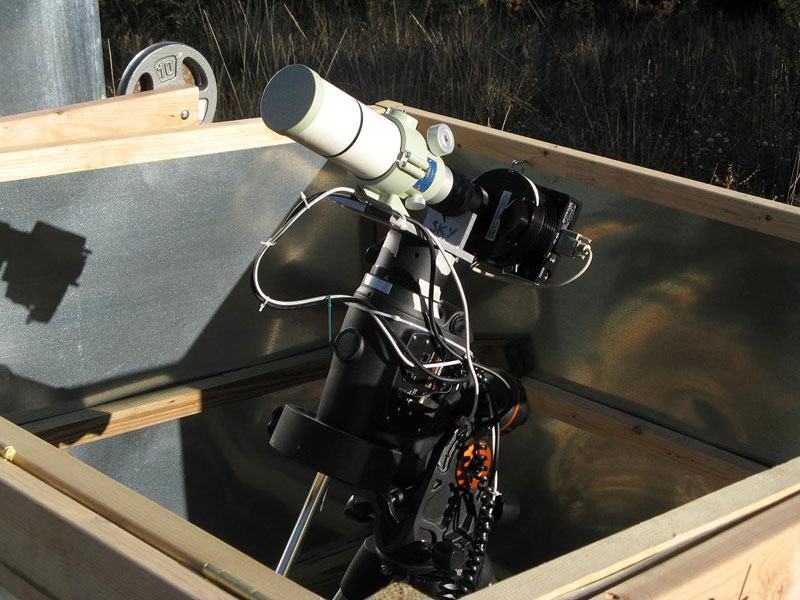
The original BSM in its enclosure outside Cloudcroft, NM.
The end result was a powerful photometric robot, featuring a field which was flat, unvignetted, and sharp. (So sharp, in fact, that we purposely defocused the telescope, as the optics would happily produce sub-pixel images!)
Under this original configuration, we found that a 30 second exposure in V saturated at V=6.5 and had a limiting magnitude of V=13. This meant that by using 0.3 second exposures, users could record quality photometry of stars as bright as V=2.0, and with a single 30 second exposure, a signal to noise ratio of 100 could be achieved on stars as faint as V=10.
It would cost about $7,000 to duplicate this system exactly. You could do it much cheaper, though, if you did not require as much flexibility; for example, by using a short-tube refractor, an inexpensive modern CMOS camera, and less expensive software.
Success!
After a heroic volunteer effort, the original BSM came online in time to observe most of the 2009-2011 eclipse of Epsilon Aurigae. The precision photometry produced by the original BSM made a significant impact on this historic light curve.
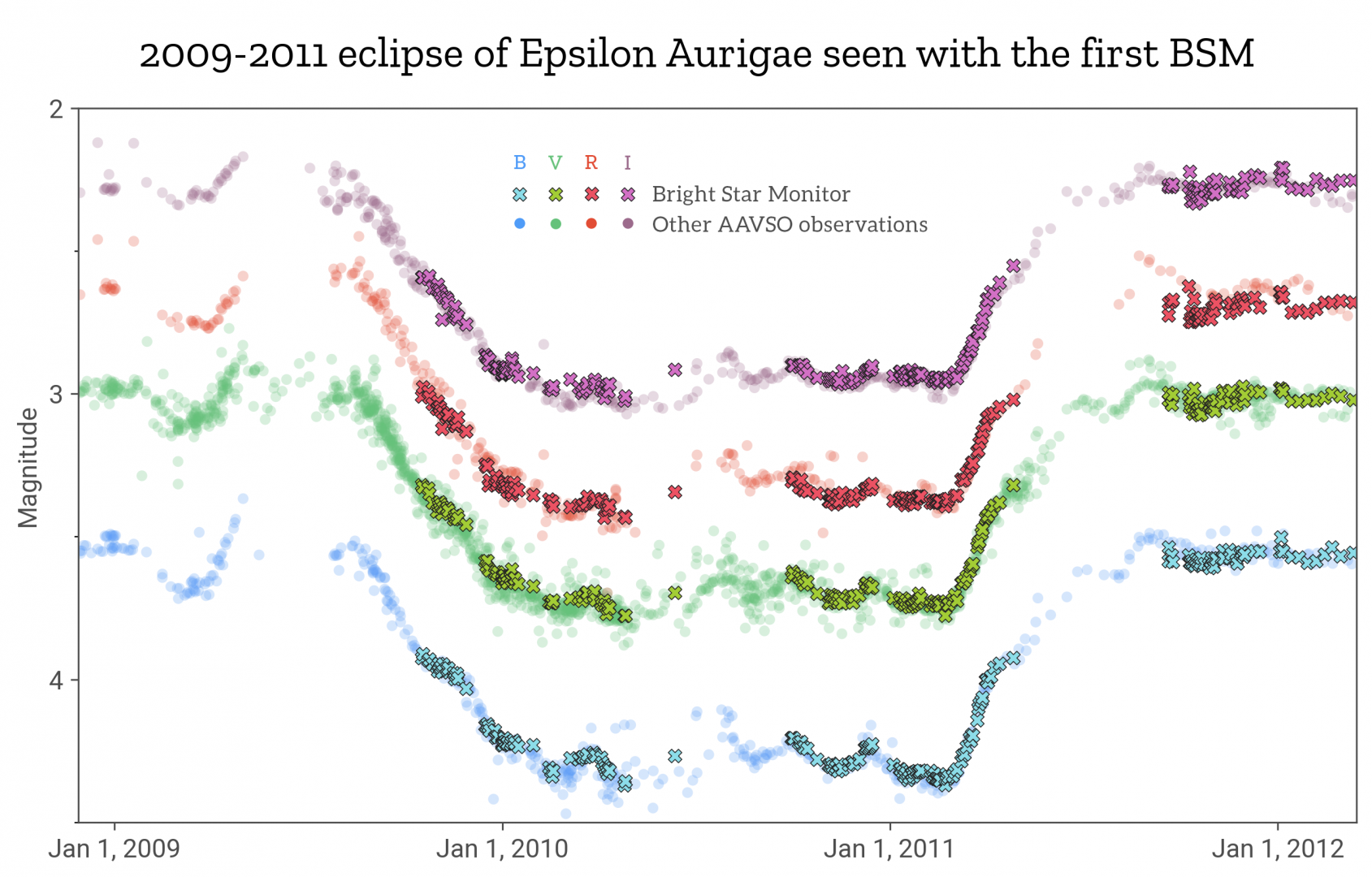
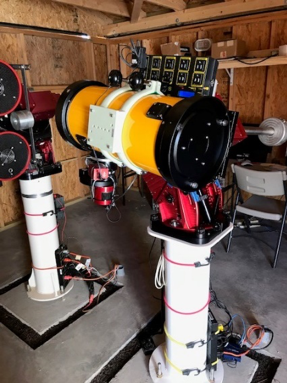
The upgraded BSM-NM in its current home in Mayhill, NM.
In 2012, the original BSM was renamed “BSM-NM” and moved down the road to Bill Stein’s observatory in Mayhill, NM, where it underwent significant upgrades. As of 2022, the station has provided well over 1,000,000 images to AAVSO observers, and shows no sign of slowing down anytime soon.
The network evolves
After the resounding success of the first BSM, we began to expand the network, deploying more stations around the globe.
The first addition to the network, BSM-S, began taking data in 2011. Located in far southern Australia, BSM-S gives AAVSO members the ability to perform photometry of the many bright and volatile stars in the southern hemisphere.
Next to come online was BSM-HQ, which operated from a perch on top of the roof the old AAVSO Headquarters building at 49 Bay State Road. BSM-HQ scanned the skies of Cambridge from Jan. 2013 through Aug. 2017, before being taken down and transported to a new home in New Hampshire. There, it spent another year taking data under the name BSM-NH before finally being replaced by BSM-NH2.
BSM-Hamren opened in September 2013, operating from under dark and equatorial skies on the big island of Hawaii. Donated by Bob Stein in honor of Merle R. Hamren, its location halfway across the Pacific ocean gives it a unique longitudinal advantage, allowing it to provide coverage of rapidly evolving variables during hours when no other observatory can.
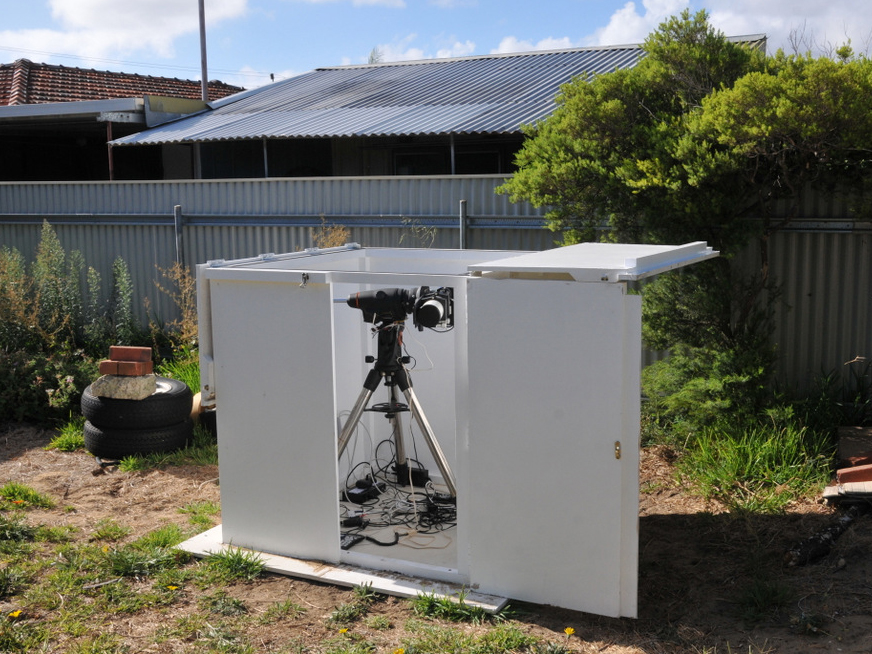
BSM-Berry in its enclosure.
BSM-Berry was donated by Richard Berry in honor of his brother, Martin Bruce Berry. Following a period of testing at AAVSO HQ, it was relocated to Perth, Australia, and became operational in early 2015. Its location on the west coast of Australia is ideal, as it enjoys an anti-correlated weather pattern to that of BSM-South to the east.
In April 2020, BSM-TX joined the lineup, bringing the total number of active BSM stations up to 6. Located in West Texas, BSM-TX boasts dark skies and dry desert conditions.
In 2014, BSM-NM and BSM-S were updated to support spectroscopy, through the addition of SA-200 diffraction gratings. These diffraction gratings screw into a filter wheel just like a regular filter, and offer AAVSO members an opportunity to record low resolution spectra of a variety of targets.
Other telescopes
Throughout the years, a few telescopes have joined the network which don't fall neatly into either of the categories "Bright Star Monitor" or "Faint Star Monitor". These include the Wright telescopes (which were the second telescopes to ever join AAVSOnet, behind SRO) and the Cohen/Menke Observatory. Although none of these remain active, they are an important part of the history of AAVSOnet. You can learn more about each of these systems at the following links:
- Wright telescopes — history, specs + more history, archived telescope pages: W28, W30
- Cohen/Menke Observatory — origin (see page 38)
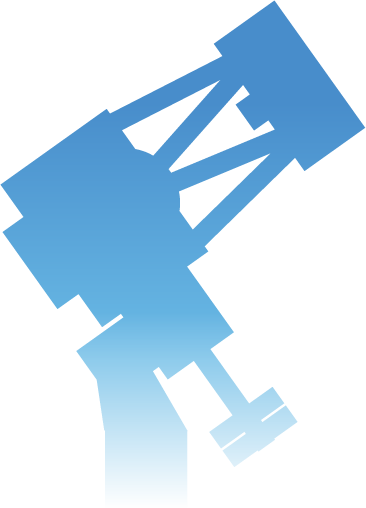
Future expansion
In the past, we've focused on finding observatories with a little something special about them, something not normally available to amateurs. No matter whether that's excellent seeing, a southern sky view, consistently favorable weather, or unusual features such as a spectrograph or a very wide field of view, it catches our attention! If you are involved with an observatory that matches that description, and you'd like to collaborate with us as a part of AAVSOnet, please reach out. AAVSOnet is far from finished growing, and we're always looking for more promising facilities!

